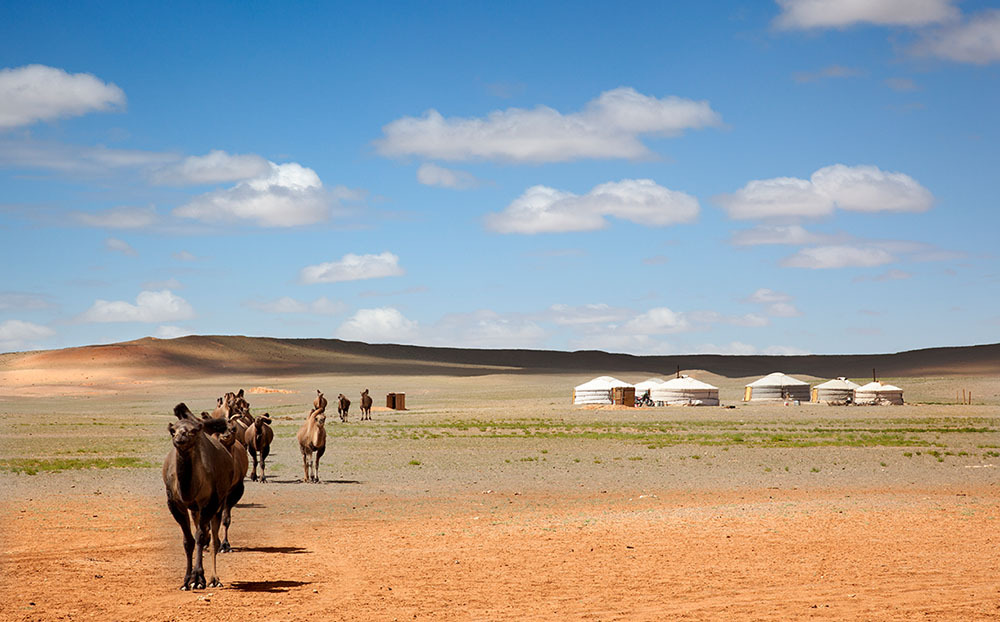Issue
Expansion of the Gobi desert is severely impacting the agricultural livelihoods of farmers in China and is affecting the wider environment due to transboundary dust storms
Solution
The Three-North Shelterbelt Forest Program (TNSFP), launched in 1978, has halted desert expansion through an ecological engineering programme of mass afforestation spanning 27.6 × 106 ha
Halting the expansion of the Gobi desert
The Gobi desert is the largest desert in Asia and the sixth largest desert in the world. Situated in the northern region of China, the desert covers an area of 2.3 million km2, occupying 30% of the country’s area. Due to its scale, the desert is known to affect regional and global climate, and is in turn affected by global climate change. The complex interactions between the factors that played a major role in the formation of the desert and the subsequent climate change makes the Gobi desert one of the most complex ecosystems to understand and manage.
The expansion of the Gobi desert is a major concern as its effects are felt from local to regional and global levels. At the local level, the Gobi desert and its expansion affect agricultural livelihoods through its effect on fertile and cultivable lands. The impact of desertification on the rangelands is also well documented as they have gradually declined. A total of 6.67 million ha of land was affected by desertification during the 1960s to 1970s, damaging 13 million ha of farmland due to wind erosion, and thus affecting the agricultural livelihoods of millions of farmers. Around 10 million ha of grasslands were affected by desertification and salinization, hundreds of water reservoirs were turned into sand reservoirs. During the 1950s and 1960s, the desert expanded at a rate of 1560 square kilometers every year. The desertification rate grew in the 1970s to 2100 square kilometers per year.
One major impact is wind erosion of topsoil that transports millions of tons of fertile topsoil, making it unproductive. Top soils are slowly becoming devoid of organic matter and often areas with high salt content are formed. In addition to these impacts, the Gobi desert is known as a climate hotspot with studies showing an acceleration of climate change in the desert area compared to the rest of mainland China. The transboundary impacts of the Gobi desert are mainly in the form of dust storms that affect vast areas of Northeast Asia including Japan, North and South Korea and even include some regions in the Pacific Ocean. The widespread dust storms are known to cause serious economic impact in these regions.
Opportunities and Pathways to Advance the Issue
The Gobi desert is expanding at an alarming rate and halting desertification is of paramount importance for the Government of China. To this end, China has implemented several programmes including the herder resettlement programme, retire livestock and restore grassland programme, grain for green programme, the natural forest conservation programme, and the Great Green Wall programme. Among these initiatives, the Three-North Shelterbelt Forest Program (TNSFP), also called the Great Green Wall of China, has been the most important initiative thus far.
TNSFP aims to establish a vast green belt area in Northern, Northwest, and Northeastern China (the Three North region) to halt the spread of the Gobi desert. The main objective of the programme is to stop dust storms and curtail wind erosion, and ensure stable agricultural production. TNSFP is regarded as one of the largest ecological conservation and restoration projects ever taken up by any government. The programme was started in 1978 and is planned to be completed in 2050. TNSFP aims at massive afforestation spanning a width of 50m and a length of 4500km, in an area of 4.1 million km2, thereby increasing the the forest area from 5% to 15% in the Three North region. The program has evolved a method of planting where a variety of grass, shrubs and trees are planted in a systematic pattern that ensures mutual protection and ensures high survival rates. A combination of manual planting and aerial afforestation methods were employed.
As a result of the TNSFP, forest area in Northern China has increased from 5.1% in 1978 to 13.5% in 2017. Afforestation across an area of 34.5138 million ha was achieved. As a result of the Great Green Wall programme, several improvements have been reported in the climatic and vegetation conditions in the three regions in Northern China, including a visible reduction in the rate of expansion of the Gobi desert, an increase in rainfall, changes in soil properties including organic matter content and water holding capacity, and a reduction in the evaporation of soil moisture. In addition, improvements have also been reported with regard to wind erosion of the soil in afforested regions. Because of this, a reduction in dust storm intensity in some pockets of the afforested regions has been reported. TNSFP has permanently treated nearly 20% of the desert land, protecting and restoring nearly 10 million ha of grasslands that were severely affected by desertification and salinization. Soil erosion was halted in 40% of the area. The programme was able to provide fuelwood with an annual output of 5.47 million tonnes, by the introduction of innovative forestry management techniques, and in addition, deforestation driven by fuelwood needs was significantly reduced. TNSFP has protected 21.3 million ha of farmland from being affected by wind erosion and related impacts. As a result, some of the regions in the project location were ranked among the top three major agricultural regions in China.
TNSFP has also provided significant water conservation benefits. During the first phase of the programme, 1.1 million ha of water conservation forests were established by taking a combination of measures such as transforming low efficient forest areas into high efficient forest areas, and carrying out afforestation in mountainous regions. Pasture shelterbelts were constructed to limit the damage to pasture land and to increase the yield and quality of forage grass. Several social benefits were also reported which include improved environmental awareness among communities, generation of gainful employment in a wide variety of occupations including in forest management and agriculture, rapid rural transformation with stable economic capacity, increased agricultural production and income, accelerated poverty reduction, and increased uptake of technologies associated with rural development and agriculture.
Key factors for success and replication
Many factors have played a role in the success of the TNSFP including the constant support and commitment provided by the national government, adequate encouragement to the three regions showing commitment to support the implementation of the programme, and engagement of people in programme implementation. An integrated approach was carried out, whereby multi-sectoral developmental plans were implemented along with the afforestation programme, instead of implementing afforestation in isolation. This took the form of a systems approach that helped provide the necessary support for full implementation of the programme across all relevant economic sectors in the regions concerned. The capacity of grassroots-level forestry officers was improved through various capacity-building measures. Similar capacity-building measures were also implemented for local communities that engaged in the implementation of the programme, so that farmers could effectively manage farmland and herders were able to sustainably manage their pastures. The experience indicates that the TNSFP is working as an effective NbS to prevent the expansion of the Gobi desert.
Location
Related Information
- Batjargal, Z., J. Dulam, and Y.S. Chung. 2006. Dust Storms are an Indication of an Unhealthy Environment in East Asia. Environmental Monitoring and Assessment, 114: 447-460.
- Forestry Department. 2021. The overall planning of the construction project of the three-north shelterbelt system.
- Sinclair et al. 2021. Rangeland condition assessment in the Gobi Desert: A quantitative approach that places stakeholder evaluations front and Centre. Ecological Economics, 181: 10.1016/j.ecolecon.2020.106891
- Tan, M. and X. Li. 2015. Does the Green Great Wall effectively decrease dust storm intensity in China? A study based on NOAA NDVI and weather station data. Land Use Policy, 43: 42-47.
- Wen, G. et al. 2013. Basic Features of Climate Change in North China during 1961–2010. Adv. in Climate Change Research, 4: 73-83.
KEYWORDS
- # Case Study
- # Agriculture
- # Biodiversity/Ecosystem
- # Forests/Forestry
- # Local Communities
- # Natural Disasters
- # Water Environment/Water Resources
- # Adaptation Action/implementation
- # Adaptation Planning/Policy
- # Capacity Building
- # Nature-based Solutions
- # Participatory Approach
- # Asia
- # China
- # 2021





